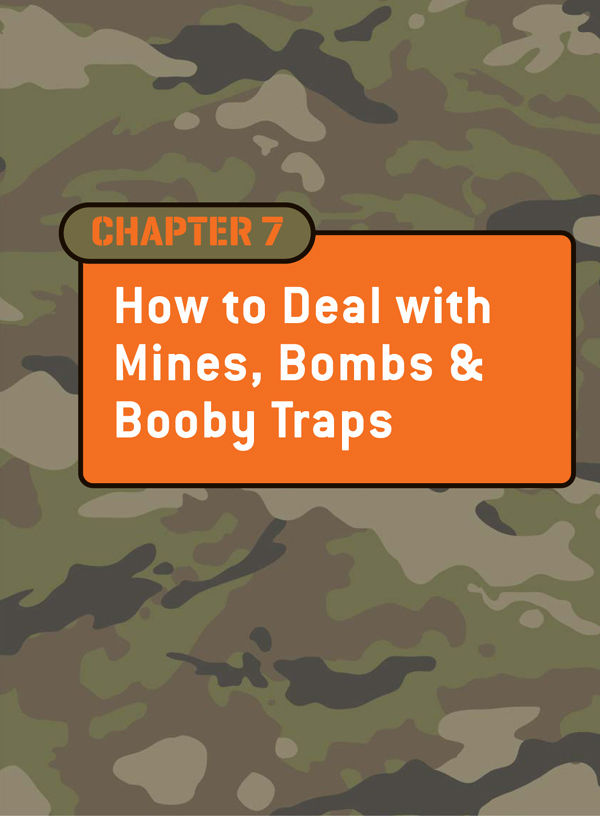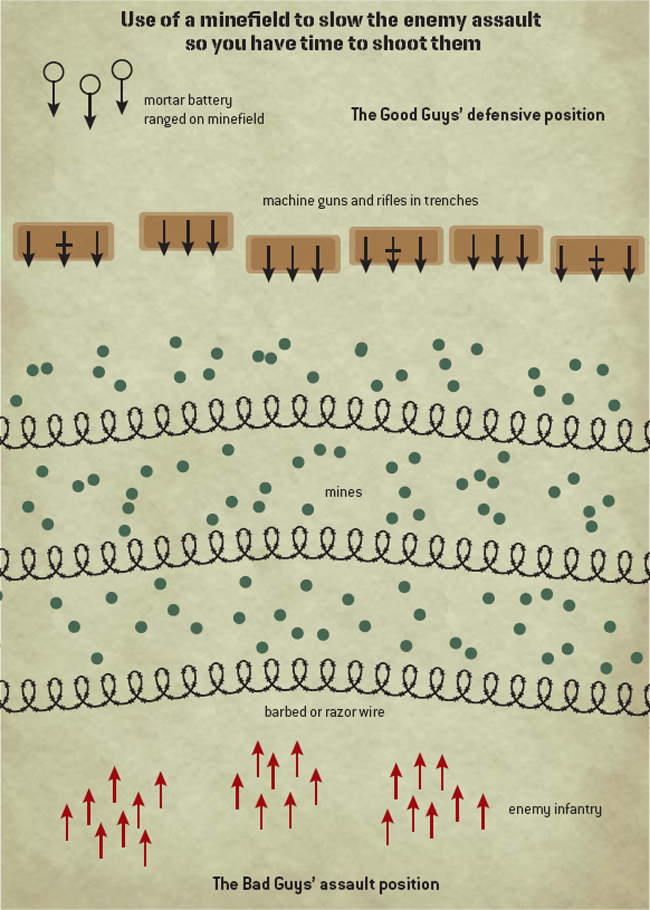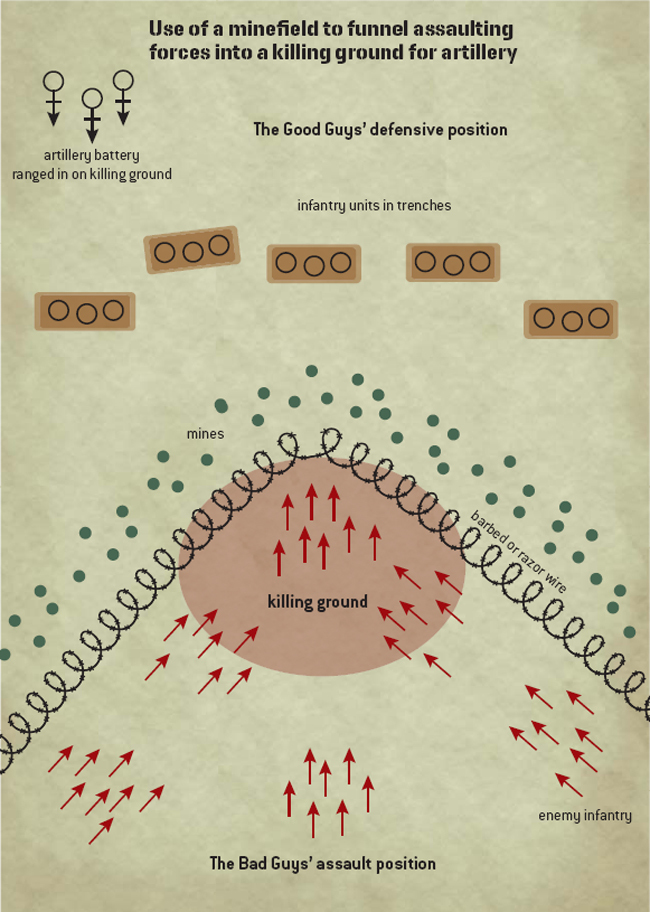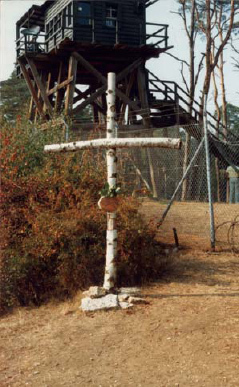
If you remember nothing else from this book remember this: in counter-insurgency warfare, mines, roadside bombs/IEDs and booby traps kill more soldiers than everything else put together – 80% in some combat zones. The reason these weapons are so popular with terrorists is that they are cheap, easily available and one man can plant enough bombs, scattered around a wide area, to make life miserable for an otherwise overwhelming number of troops. The reason these weapons are so effective is that they are rather difficult to defeat. Difficult but not impossible if you remember your SOPs.
We have seen earlier how the main types of conventional, shop-bought, mines work. In this section we will look at how these mines are deployed in conventional warfare and how they are overcome. Then we will move on to look at how IEDs and booby traps work. Once we understand all these threats we can then look at how terrorists use mines, IEDs and booby traps in counter-terrorist warfare and, most importantly, how we can defeat them.
A friend of mine – the same fearless Taff Davies who saved my neck when I was hit by a grenade blast – was once part of a large patrol of 51 men. They were walking in single file, the regulation 5 yards apart. More than half the line walked over the mine without setting it off but then one was unlucky. We guess there was an AP mine placed on top of an anti-tank mine to make a big bang. The poor guy who trod on it, BEHIND Taff, went 50 feet into the air screaming all the way up and all the way down. The blast cut off both his legs at the hip, one arm at the shoulder and left one bone to the elbow on his other side. They only found the barrel of his rifle. Unfortunately, he remained fully conscious throughout the experience and lasted 90 minutes before he died. The flash from the blast had heat-sealed the wounds so he didn’t continue to lose blood. Taff went to render assistance but what can you do? There was no chance of a casevac where they were and the best medics couldn’t save someone in that state all those years ago. Taff took out a saline drip pack but while he was wondering where to put it, the victim used the bit of bone remaining from his arm to try to beat him away. It seems likely he wanted to be out of it as soon as possible which seems reasonable to me.
CONVENTIONAL MINE WARFARE TACTICS
People usually think of the landmine in isolation as something a person steps on or a vehicle drives over with the obvious result. This is not what they were designed for originally and their use as hidden explosive devices is strictly outlawed by the Geneva Convention. According to the Convention, all mined areas must be clearly marked as such on the ground and on maps. There should be tape and signs to make civilians and troops aware of their presence and allow for later disposal. Why would anyone want to warn people?

‘Danger Mines’ – children playing in Cambodia. (i-Stock)
The reason a minefield should be marked is obvious when you think about it. If a person knows there are mines in an area they will keep away from it. Simple really. And keeping people away by the threat of death is the ideal use of mines in most conventional situations. Let me explain. There are three ways in which mines can be usefully and legally used: to slow the advance of an enemy force, to funnel an attacking force into an area where they can be destroyed and finally to deny the use of ground to an enemy. This last may be problematic as we shall see.
In case you were wondering, I have avoided discussing mine laying patterns and density in case that were a help to our enemies. If you get to lay mines you will be told how and where.
To slow an attacking force
You probably already know that the conventional way to assault the enemy is to get their heads down with suppressing fire and then rush at them to finish them off. If you are not fully aware of the principle tactics of infantry warfare don’t worry as they are covered later. The point is that if you are on the receiving end of an attack the enemy is trying to keep your heads down with suppressing fire and come at you faster than you can shoot them down. They already outnumber you heavily or they would not be launching an assault so what can you to do slow them down while you shoot them?

There are two main ways of slowing down the advance of an enemy trying to assault your position large, or small. These are barbed wire and mines. Preferably used together for optimum effect. All you do is lay a pattern of mines and strings of barbed wire across the approaches to your position, make sure they are covered by fire, and then sit back and wait. When the enemy approaches, the mines and wire will certainly slow them down a great deal as they cannot approach faster than a leading man or vehicle can clear the mines. Slowing the assaulting troops gives you a massive advantage as they ought to be crossing open ground to get to you and you will be dug in like ticks on a hog with your guns laid on the minefield. Won’t you?
To funnel an attacking force
If you were attacking an enemy position you would spread out your men to make a less concentrated target. You should have been taught not to bunch up in tactics at squad level but the principle continues right up to Battle Group level. In small engagements when you bunch up you make a target for a machine gun. In a large engagement you make a target for artillery or air strike.
If you are on the defending side then you want to get the enemy to bunch up so you can kill them more easily. One way to do this is with a marked minefield laid out in such a way that by changing direction to avoid the mines, the attacking force is channelled into a killing zone which you have plotted for a strike by mortars, artillery or air cover. You will remember from the earlier section on avoiding artillery that all three of these weapons systems work best when the target is above ground. By definition, an attacking force is moving and above ground and if you can get them to bunch up where you want them then, for the artillery, it is like shooting fish in a barrel.
Borders
It is totally acceptable, according to the Convention, to lay and mark a minefield on a border to stop civilians or military units from crossing it. Very often there will be guards to shoot anyone making the attempt and sometimes even to finish off the wounded. Landmines were planted by the Communist East German State on the old demarcation line between Communist East and Capitalist West Germany. The mines were there to discourage civilians from venturing across from the poor East in search of a better life in the prosperous West. The guards used to leave the wounded and dead out in the minefields for a while as a discouragement to others considering a vacation to the bright lights.


East German border with tower, fence, mines and the inevitable memorial to a failed escaper. (Photo courtesy Sergeant Roy Mobsby)
Protect fixed camps
You may have a major fixed camp – like Bastion in Afghanistan – where the concern is really about terrorists creeping up and taking pot shots at you rather than mounting a full-scale assault. In this case you can use a minefield to discourage the locals from coming too close under cover of darkness, fog or dust storm.
Deny strategic points
There may be hills or other strategic points which you do not want to occupy but which you would sooner the enemy did not occupy either. An acceptable way to do this is to plant a minefield and mark it. In this case, you should take extra care to make the mines more difficult to detect perhaps including various booby traps and other entertainments. You might use this tactic when a hill overlooks your defensive position and you cannot station men there to deny it to the enemy.